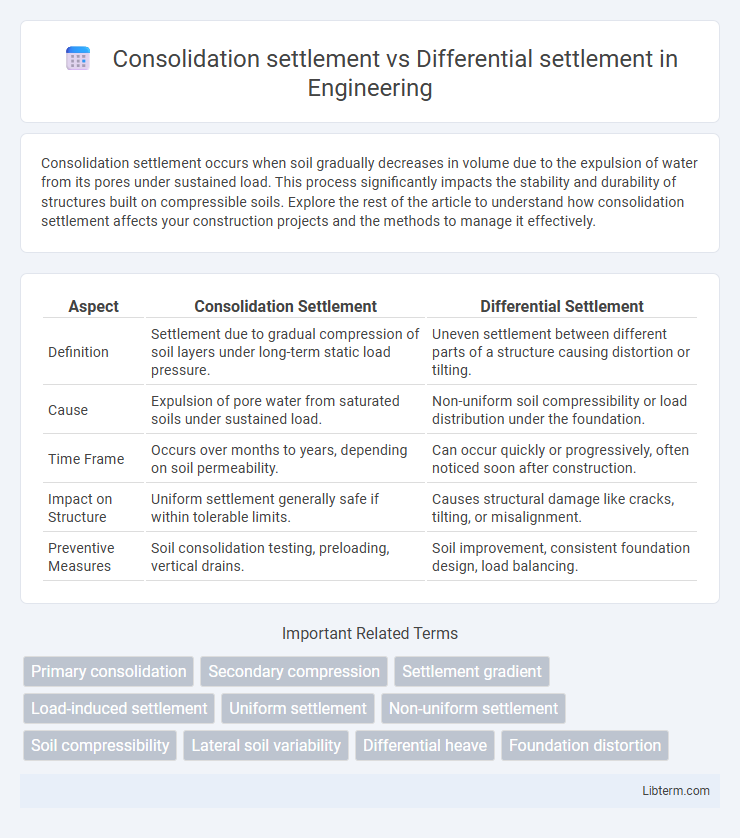Consolidation settlement occurs when soil gradually decreases in volume due to the expulsion of water from its pores under sustained load. This process significantly impacts the stability and durability of structures built on compressible soils. Explore the rest of the article to understand how consolidation settlement affects your construction projects and the methods to manage it effectively.
Table of Comparison
| Aspect | Consolidation Settlement | Differential Settlement |
|---|---|---|
| Definition | Settlement due to gradual compression of soil layers under long-term static load pressure. | Uneven settlement between different parts of a structure causing distortion or tilting. |
| Cause | Expulsion of pore water from saturated soils under sustained load. | Non-uniform soil compressibility or load distribution under the foundation. |
| Time Frame | Occurs over months to years, depending on soil permeability. | Can occur quickly or progressively, often noticed soon after construction. |
| Impact on Structure | Uniform settlement generally safe if within tolerable limits. | Causes structural damage like cracks, tilting, or misalignment. |
| Preventive Measures | Soil consolidation testing, preloading, vertical drains. | Soil improvement, consistent foundation design, load balancing. |
Understanding Settlement in Geotechnical Engineering
Consolidation settlement occurs when soil gradually decreases in volume due to the expulsion of water from its pores under sustained load, primarily affecting clayey soils with low permeability. Differential settlement refers to the uneven subsidence of a structure caused by variations in soil properties, load distribution, or foundation conditions, leading to structural stress and potential damage. Understanding these settlement types is crucial for designing foundations that ensure structural stability and longevity in geotechnical engineering projects.
Defining Consolidation Settlement
Consolidation settlement refers to the gradual decrease in soil volume caused by the expulsion of water from saturated clay layers under sustained load, resulting in long-term settlement over months or years. This phenomenon primarily affects cohesive soils where pore water pressure dissipates slowly, leading to a time-dependent compression of the soil structure. In contrast, differential settlement involves uneven subsidence across a structure's foundation, which can cause structural damage and instability.
What is Differential Settlement?
Differential settlement occurs when different parts of a structure's foundation settle unevenly due to variations in soil properties, load distribution, or moisture content. This uneven settling can cause structural stress, cracks, and potential failure, impacting the integrity of buildings and infrastructure. Unlike uniform consolidation settlement, differential settlement is localized and varies in magnitude across the foundation area.
Causes of Consolidation Settlement
Consolidation settlement occurs due to the gradual expulsion of water from the soil pores under sustained load, primarily affecting cohesive soils such as clays. The primary cause is the compression of soil particles as pore water pressure dissipates over time, leading to a reduction in soil volume. Differential settlement arises when parts of a structure experience unequal soil compression, often due to variations in soil type, moisture content, or load distribution.
Common Factors Leading to Differential Settlement
Differential settlement occurs when different parts of a structure settle unevenly due to variations in soil properties, moisture content, and load distribution, contrasting with uniform consolidation settlement that happens evenly across the foundation. Common factors leading to differential settlement include inconsistent soil compressibility, presence of localized voids or weak zones, and varying groundwater levels causing uneven soil consolidation. These disparities result in structural distortions, making site-specific soil investigation and proper foundation design critical for mitigating differential settlement risks.
Measuring and Monitoring Settlement Types
Measuring consolidation settlement involves monitoring changes in soil volume due to expulsion of water under sustained load, typically using settlement plates, piezometers, and time-dependent soil compression curves. Differential settlement is assessed by tracking relative movement between different points on a structure using precise leveling, tilt meters, and crack gauges to detect uneven foundation displacement. Effective monitoring combines geotechnical instrumentation data with structural health sensors to distinguish uniform consolidation from problematic differential settlement.
Impacts of Consolidation vs. Differential Settlement
Consolidation settlement primarily causes uniform vertical displacement as soil layers compress under sustained loads, leading to predictable settlement in structures. Differential settlement occurs when unequal compression or soil variability causes uneven settling, resulting in structural damage such as cracks, tilting, and misalignment. Understanding the distinct impacts of consolidation versus differential settlement is crucial for designing foundations that minimize structural distress and ensure stability over time.
Prevention and Remediation Techniques
Consolidation settlement occurs due to soil compression over time under sustained loads, while differential settlement arises from uneven soil support causing structural distortion. Prevention techniques for consolidation settlement include preloading, vertical drains, and soil stabilization to accelerate consolidation and increase soil strength. Remediation methods for differential settlement involve underpinning, grout injection, and installing adjustable foundations to restore structural alignment and support.
Case Studies: Field Examples and Lessons Learned
Case studies on consolidation settlement demonstrate slow soil compression under long-term static loads, commonly observed in clay deposits beneath foundations or embankments, leading to uniform settlement patterns critical for structural stability. Differential settlement case analyses reveal uneven ground movement due to variable soil properties or loading conditions, often causing structural distress such as cracks or tilting, highlighted in bridge and building foundation failures. Lessons learned emphasize thorough geotechnical investigation and tailored foundation design to mitigate risks, including staged loading and soil improvement techniques to minimize both consolidation and differential settlements.
Key Considerations for Construction Projects
Consolidation settlement involves soil volume decrease due to gradual water expulsion under sustained load, critical for predicting long-term foundation performance and preventing structural damage. Differential settlement occurs when uneven compression or support leads to varying settlement levels across a structure, requiring careful site assessment and foundation design to avoid cracks and misalignment. Construction projects must prioritize accurate soil testing, load distribution analysis, and selection of appropriate foundation systems to mitigate risks associated with both consolidation and differential settlements.
Consolidation settlement Infographic

 libterm.com
libterm.com